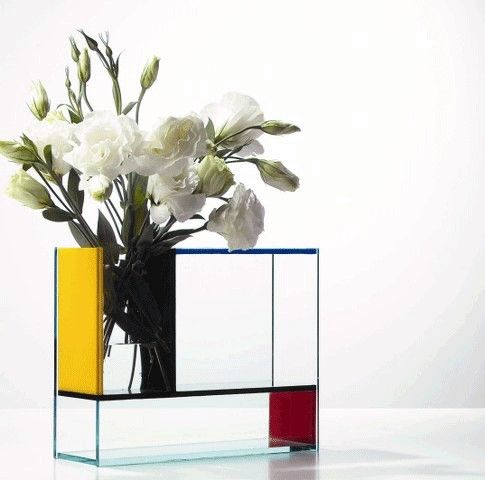大师何为大师?
简介
彼埃·蒙德里安(Piet Cornelies Mondrian;1872年3月7日-1944年2月1日),荷兰画家,风格派运动幕后艺术家和非具象绘画的创始者之一,对后代的建筑、设计等影响很大。
蒙德里安及其荷兰“风格派”,作为一种艺术运动,并不局限于绘画。它对当时的建筑、家具、装饰艺术以及印刷业都有一定的影响。事实上,“风格派”内的许多成员正是各艺术领域的积极活动家。提到蒙德里安,我们马上会想到那些规格不同的矩形方格子。某些美术评论家认为蒙的作品只适用于广告设计、家具、印刷品和建筑装潢,根本谈不上“绘画”二字。这种批评其实是抽象的,因它离开了时代特征,当时蒙德里安不这样认为,他一步一步地走上绘画几何学的抽象构图道路,是沿着立体派和未来派的单纯化结构而来的。
下面翻译一则国外的文章
Our eyes are far too good for us. They show us so much that we cant take it all in, so we shut out most of the world, and try to look at things as briskly and efficiently as possible.What happens if we stop, and take the time to look more carefully? Then the world unfolds like a flower, full of colors and shapes that we had never suspected.In this column, I am going to be pondering how we see the world. I will be describing how to look at paintings, photographs, and sculptures (that is my field, art), but also grass, sand, twigs, sunsets, Egyptian scarabs, discolored porcelain teeth, cheddar cheese, viruses, X-Rays, spectra, fingerprints, candle flames, galaxies, graphs of bird song, engineering drawings, ice halos behind palm trees, the lines in an elderly face, the ripples of muscle in a shoulder, the logic of crystals, the colors in a rainbow, the shapes of culverts, the species of mirages, the faint lights in the night sky, the zig-zag patterns on moths wings, the engraved designs in postage stamps, the things you can contrive to see inside your own eyes.
我打算漫谈我们看待这个世界的方式。我会说说怎么看待绘画、摄影、以及雕塑(这些艺术算是我的专业领域),但同时还有草叶、沙粒、枝桠、日落、古埃及的圣甲虫、褪色的陶瓷牙齿、英国的切达芝士、病毒、X光、光谱、指纹、烛光、星系、鸟鸣声谱、工程制图、棕榈树后的光晕、老人脸上的皱纹、肩部肌肉的起伏、晶体的结构、彩虹的色彩、水渠的形状、海市蜃楼的种类、夜空中的微光、飞蛾翅膀的蜿蜒、还有邮票上的雕刻设计,那些你用自己的双眼无法捕捉到的事物。
What I have in mind is a series of lessons about how to use your eyes more concertedly, with more patience, than you might ordinarily do. Its about stopping, and taking the time to simply look, and keep looking, until the details of the world slowly reveal themselves. I especially love the strange feeling I get when I am staring at something, and suddenly I understand: the object has structure, it speaks to me. What was once a shimmer on the horizon becomes a specific kind of mirage, and it tells me about the shape of the air I am walking through. What was once a meaningless pattern on a moths wing becomes a code, and it tells me how that moth looks to other moths. And paintings show me more each time I look; there is apparently no limit to what they can mean.
我现在想到一连串的内容,都是关于怎样比平常更耐心更自如地运用你的双眼。关键在于逗留,把时间充分用于观看,并且保持观看,直到每个细节都慢慢地展露出来。我尤其享受一种奇特的感觉,就是当我盯着某件东西,然后顿悟的瞬间:原来这样东西是有结构的,它本身就在和我对话。
My opening example is Mondrian.
Specifically, one of the Mondrian paintings in the collection of the Art Institute of Chicago, across the street from where I work. It is called Lozenge Composition with Yellow, Black, Blue, Red, and Gray and it was painted in 1921. Its a simple picture: off-white, with black stripes and four color areas: black, blue, pale lemon yellow, and a touch of orangey red. At least thats what I thought before I had looked closely at it.
我的首例就是蒙德里安。
具体地说,是我工作的大街对面的芝加哥美术馆收藏的一幅蒙德里安画作。这幅叫《黄、黑、蓝、红、灰菱形构图》的画作绘于1921年。这是幅简单的作品:灰白背景,黑线条,以及四个色块——黑色、蓝色、淡淡的柠檬黄、和少许橘红色。至少在近距离看它之前,我是这么认为的。
I have occasionally taught a course in which students copy paintings in the museum. The course was open to anyone, even students who had never painted. The only requirement was bravery, because it turns out that when you put up an easel and canvas in the museum, everyone talks to you. They give you advice and criticism, and they arent always polite. One of my students was harangued for choosing to paint a nude, "even though," as the angry visitor said, "youre a woman yourself." Another time, a guard asked me if I thought my student was worthy of copying a small painting showing Moses crossing the Red Sea. "Do you think your student believes the Bible story?" the guard asked. I said, "I dont know, but do you think the painter believed in the Bible?" He said he wasnt sure, and hed get back to me. The next week, he said hed decided the painter was an atheist, because the painting didnt have enough thunder and lightning in it--it wasnt dramatic enough to ring true. (I think the guard was thinking of the movie "The Ten Commandments.") After that, the guard left us alone: he decided that a non-believer could copy a non-believers painting, but he just wasnt interested in the result.
我教过一门课专门让学生临摹展馆里的绘画。这门课面向任何人,甚至是从没画过画的学生。唯一的要求是勇气,因为在博物馆里支起画架放上画布的结果是,人人都来和你说话。他们会对你的画指手划脚,而且不一定客气。我有个学生就曾因为选择临摹裸女被大声训斥过,“尽管你自己也是个女的。”那个气愤的参观者说。还有一次,一个保安问我觉得某个学生临摹一副摩西穿越红海的小画值不值得。他问:“你看这个学生相不相信圣经?”我说:“不知道,但你看这个画家相不相信?”他回答说不确定,但是会稍后给我回答。到第二周,他告诉我确信了这幅画的作者是个无神论者,因为画里没有足够的雷鸣电闪——不够戏剧化也就不足以为真。(我估计他想像的是《十诫》的那种情形。)再之后,这个保安就不管我们了:他表示无信仰者是可以临摹无信仰者的画的,他只是对结果不再感兴趣了。
When one of my students asked to copy that Mondrian, I said it might not be very rewarding, because it was so simple. It turns out I was very wrong, and since then Ive had three students try to copy the painting. Its a very difficult and complex image, masquerading as a simple abstraction.
If you step right up to the cordon, youll see that Mondrian changed his mind about whether the stripes should go right up to the edges of the canvas. He painted out the ends of the stripes, so that they appear to stop where the canvas stops.
当一个学生要求临摹蒙德里安的时候,我回应说那对他不一定有什么好处,因为这画太简单了。可结果我完全错了,并且从那时起已经有3个学生试着临摹这画。这是一个相当困难复杂的图像,只是被冒充成简单的抽象画罢了。
如果你从右边的边线开始画,你会发现这里蒙德里安改变了主意,没让线条继续往上走到画布的边缘。他描出了线条的终点,使之看起来结束在画布边缘。
(All photos: author.)
He wasnt especially careful with his repainting, which is a clue to how closely he expected people to look. Art historians have noticed his change of mind, and it has been said that before the early 1920s, Mondrian thought of his compositions as part of an infinite plane, which could go on indefinitely in all directions. Starting with paintings like this one, the canvas is the whole object, the whole universe, and there is nothing beyond it.
他在重画的时候不是那么细心,所以可以推断出他当时估计人们看画时的距离。艺术史学家注意到他改变了想法,而且据说在20世纪20年代前,蒙德里安曾把他的作品当作是无限平面上的一部分,所以每个方向都会无限延伸。从诸如这样的绘画开始,画布就成为一个完整的对象,完整的宇宙,没有任何东西可以超越。
If you bend down, and look up against the light--often a good trick in museums, because it reveals flaws and shows off the paintings surface--you can also see that Mondrian painted the black rectangle with thin paint, so the warp and weft of the canvas shows through. (The warp and weft are at forty-five degrees to the stripes, because the stretcher is rotated.) The yellow area is painted much more thickly.
An even closer look at the yellow shows how luscious the paint surfaces are, some ribbed, some rubbed into the weave. Its also possible to see how Mondrian smoothed the edges of the yellow region, creating a glossy painted frame.
如果你蹲下身,逆光往上看这幅画——在展馆里是个很狡猾的办法,因为这样会暴露出画作的裂缝以及表面——从画布的纹理可以看出蒙氏画作中黑色长方形用的颜料较薄。(画布纹理与线条呈45度,原因是框架是转过的)而黄色色块使用的颜料就厚重多了。
再凑近点看黄色区域能发现这个绘画表面相当丰郁,一部分起了棱纹,一部分渗入了纺线里面。这里也能看出蒙德里安打磨了黄色色块的边缘,弄出了一个光滑的边框。
Each surface and stripe has its texture: the stripes are scored with little ridges, and some of the surfaces, like the blue area, show those freehand back-and-forth brush textures house painters try to avoid. Altogether the painting is rich in surface textures, what art historians call facture.
每个表面和线条都有它的纹理:条纹被刻出了脊线;一些表面,比如蓝色区域,有油漆工人试图避免的徒手画出来回刷笔的纹理痕迹。放在一起这幅画作有了丰富的表面纹理,艺术史学家称之为制作法。
My student tried hard to get the thick furred look of the blue area, but all he could manage was a flaccid, watery pool of blue:
我的学生花了很多力气想弄出蓝色色块上厚实茂密的表面,但是他的努力只得到一片松软散淡的蓝色:
So far none of this is new to art history, and there have also been some very careful analyses of the ways some stripes go over others, and how Mondrian built his paintings into a kind of woven bas-relief. (There are excellent accounts of this by Yve-Alain Bois and Harry Cooper.) But it is not difficult to go beyond what has been discussed in art history.
目前为止提到的对艺术史都不是什么新鲜事,除此之外还有很多谨慎的分析讲到线条如何相交,蒙德里安如何把他的绘画塑造成浅浮雕编织。(维亚阿兰保尔和哈利库珀的评论里非常多的证据。)然而,要往超出这些艺术史的讨论之外了说也不难。
If you look very closely at the borders of the stripes, you see they arent just lines where black meets white or blue or yellow. The edges of the stripes are rough. It is known that Mondrian painted his stripes by laying down strips of paper, the way decorators and contemporary painters use masking tape. But that produces a clean border, and the borders in this painting are messy. Unfortunately, with the naked eye its hard to see exactly what makes them messy.
如果你向这些条带的边界凑得非常近的话,你会看到它们并不只是单纯的黑与白或蓝或黄交会的线。这些条带的边缘是粗糙的。据悉蒙德里安是用铺上纸条来画的,就像很多装潢师和当代画家用封口胶纸的道理一样。但是这种办法可以形成一个清爽的边界,而这幅画里的边界却是混乱的。不幸的是,肉眼很难看出到底是什么搅乱了它们。
I have two devices to me solve mysteries like that: a camera with a macro lens, and a pair of surgeons glasses, which are heavy metal frames with little binocular telescopes mounted on them. The little telescopes are amazing: if I stretch my arm out in front of me, the telescopes focus on one-quarter of one of my fingernails. (The surgeons glasses are also embarrassing to use, because they have a kind of dorky mad scientist look. My student and I got lots of odd stares while we were inspecting the painting.)
我有两个设备来揭开这个谜:一架有微距镜头的相机,和一副内置了微型双目显微镜的重金属框架手术眼镜。微型显微镜太厉害了:如果我在身前伸展胳膊,显微镜会聚焦到我一片手指甲上的一小块。(手术眼镜倒是让我用得有些难堪,因为它戴起来就像个呆里呆气的疯狂科学家。在勘测这幅画时,我和我学生就荣获了不少古怪的注目礼。
In this photograph, taken with my macro lens, my student is trying to reproduce the complicated marks at the border of one of the stripes. (He is wearing plastic gloves to protect himself from the toxic chemicals in the paint; some painters prefer the old, poisonous solvents and pigments to the new healthier materials.) He is painting freehand, without a paper strip to help him, because he thought that is what Mondrian did.
在这张用我的微距镜头拍下的照片中,我的学生试图复制其中一条条带边界的复杂的痕迹。(他戴着塑胶手套以防止颜料里的有害物质;一些画家会宁可选择旧的有毒溶剂而不是新的更安全的材料。)他在徒手作画,也没有用纸条辅助,因为他觉得蒙德里安就是这么做的。
A closer look at the original shows that Mondrian did put a paper strip down, and he painted over it to get a sharp edge: but then he removed the strip, put another one down in a slightly different place, painted over that one, and so on, creating a kind of little stairway of paint.
而靠近蒙德里安的原作看可以发现他的确铺过纸条上去,而且他从上面涂过以得到一个利落的边缘:但是之后他移动了这张纸条,在略微不同的地方铺上了另外一张,涂过了那张上面,诸如此类,结果就成了一种阶梯状的绘作。
In other parts of the painting, Mondrian clearly painted freehand, with no paper to guide him. On one place, its possible to see how he painted vertically, carefully edging up to the stripe. To see that, look very closely at the bottom edge of the stripe in the next photo, about an inch to the left of center.
在这幅画的其他部分,蒙德里安显然是用徒手画的,完全没有用纸条引导。在一个地方,可以看出他是怎样垂直往,小心地绘完这条带子。要想发现这点,可以往下张照片里的条带底部边缘,也就是中心偏左一寸左右,使劲凑近看。
My student and I studied that, but again his copy failed, because he couldnt get just the right texture of paint--Mondrians paint was sticky, and the bristles on his brushes were stiff. My student ended up with an ugly ridge of paint:
我学生和我的研究结果是,他的临摹再一次失败是因为他没法弄出笔触的准确质地——蒙德里安的颜料非常的粘稠,而且他画笔上的毛刷非常坚硬。我学生的最后画出的是一个难看的边脊:
In some places, Mondrian painted parallel to his stripes, trying to keep his hand from wavering. In other places it seems he enjoyed the slight tremble and wander of his hand. There is a lot to see in this last detail: underneath the stripe, you can see where Mondrian carefully edged his brush up to the stripe, overlapping some horizontal marks hed made freehand. Over the stripe there is a thick hedge of short marks, all freehand, intended to give the stripe a rich, entangled margin.
在某些地方,蒙德里安以和线条平行的方向作画,以避免让手摇晃。而在其他地方,他似乎挺满意手上轻微的颤抖和晃动。在最后一张细节图上有很多值得注意的地方:在条带下面,你可以找到蒙德里安小心的在线条上收尾,改过他徒手水平画的痕迹。在线条之上有一栏很厚的短痕迹,全部徒手,为这个条带形成丰富而相互缠绕的边缘。
You dont see any of this from two or three feet away, and its clear Mondrian expected his viewers to stand back so they wouldnt see things like the sloppy way he truncated the ends of his stripes. But you are aware of a richness, a shimmering effect, a depth. The paintings are three-dimensional. The paint has visible gestures, it is human, it moves. In the language of art history, it is painterly. It belongs to the tradition of Titian and Rembrandt and Delacroix, and not just to the asceticism and idealism of the early twentieth century.
从两三步之外你是完全看不出这些的,显然蒙德里安估计观者应该往后站从而不会发现像他截断条纹末端的草率。但是你意识到一种丰富,光耀的效果,一种深度。这幅画是三维的。画有看得见的姿态,它是人性的,是灵动的。在艺术史的语言里,它是画家式的。它属于提香、伦勃朗和德拉克洛瓦的教派,而不仅仅是20世纪初期的禁欲主义和唯心主义。
In the Art Institute of Chicago, as in many museums, the Mondrians hang next to other paintings of the time, also geometric and abstract. In comparison to their resolute, sterile flatness, Mondrians paintings have depth. They speak to the deeper history of painting. Its true Mondrian is forbidding, ascetic, pure, impersonal, ideal, clear beyond the mess of an ordinary life. But it is also true that he was thinking of Old Masters, and of what paint could do. He just kept the poetry so tightly reined that it is nearly invisible.
在芝加哥美术馆,和在许多别的展馆一样,蒙德里安的画作被悬挂在了同时期的同样是几何和抽象的作品边上。与它们坚决而枯燥的平坦不同,蒙德里安的绘画是有深度的。它们在向绘画的历史深处诉说。诚然蒙德里安是严峻的、禁欲的、单纯的、冷漠的、唯心的,明显凌驾于世俗生活的喧嚣之外。然而他心念着早期的绘画巨匠,思索着绘画能做什么也是事实。他只是把那份诗意封锁得太紧以至于几乎看不见了。
Perhaps it requires a slightly abnormal sort of seeing to notice all this--geeky doctors glasses, an expensive camera lens, a student who is willing to fail while people watch. But once you have seen how the painting works, Mondrian will never be the same.
可能这些还是需要某些非常手段才能注意到——比如怪胎医生的眼镜、昂贵的相机镜头,还有敢于在众人面前失败的学生。但是一旦你看到这幅画是怎样完成的,蒙德里安就和之前不再是同一个人了。
I know there are many questions lingering here. What is close looking, exactly? What happens to the experience of the artwork when you look very slowly? It seems artificial or unnatural to look closely: after all, it runs against the grain of todays very distracted, fast-motion seeing. And yet poets do it all the time: close reading is part of good reading.
我知道还有很多没解决的问题。到底什么才是细看?缓慢地观看艺术作品会带来怎样的经验转变?看起来细看是很做作而不自然的:毕竟这违背了今天分散而快速移动的观看方式。而诗人却一直那样做:文本细读是精读的一部分。
I am up for all those subjects, and more. I hope this column will inspire you to stop and consider art more closely, but also to see all sorts of things that are absolutely ordinary, things so clearly meaningless that they never seemed worth a second thought. Once you start seeing them, the world--which can look so dull, so empty of interest--will gather before your eyes and become thick with meaning.
我希望这篇文章能激发你去停留去更细致地思考艺术,同时去观赏生活中最平凡的那些事物,那些似乎都不值得再看一眼的事物。一旦你开始凝视它们,这个世界——这个本来如此乏味而了无乐趣的世界——会在你的眼前重新组合,浓墨重彩,意味深长。
文献参考资料
[1]原文 http://www.huffingtonpost.com/james-elkins/post_1036_b_756669.html
[2]译文 http://select.yeeyan.org/view/135550/145631
他的画稿
Alberi 1908
At The Amstel Sun
Broadway Boogie Woogie 1943
Amaryllis 1910
Anemones In A Vase
加刘景长语:有的东西或许你觉得很简单,只是因为不知道那有多难。(此话并不用于#你行你上#这种逻辑)
很多人第一次看到蒙德里安的作品也是一样不解他就是摆了几个色块为何能成为大师,但实际上看似随意的色块和线条都是经过精细的配比和组织。
现在蒙德里安的作品理念已经被应用到生活的方方面面。



